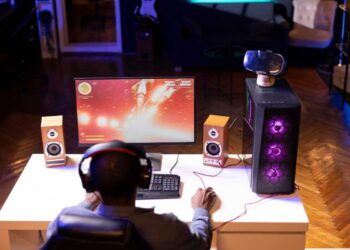Ever watched a live dealer shuffle cards and wondered if there’s any digital trickery happening? I sure did. That’s why I spent weeks researching how these setups actually work.
Turns out, live dealer games blend old-school casino action with some seriously advanced tech. And knowing what’s happening behind the scenes changes how you should approach these games.
For a comprehensive live dealer experience, platforms like Stake Casino Canada showcase how modern technology enhances gameplay with their extensive live casino section featuring professionally trained dealers. Their crypto-focused payment system processes transactions without delays, while their 3,000+ game selection includes live dealer options from multiple premium providers streamed in high definition.
The Three-Room Setup You Never See
When you play a live dealer game, you’re watching just one room of a multi-room operation:
- The studio floor: Where dealers run the games you see
- The software room: Where game results get processed and streamed
- The analyst room: Where specialists monitor gameplay and security
Most studios have at least these three distinct areas working together to deliver the seamless experience you see on screen. But what happens beyond the dealer’s table determines your experience.
Warning: If a live casino doesn’t disclose its studio location, be skeptical. Legitimate operations proudly list where they’re based—usually Latvia, Malta, or the Philippines.
OCR Technology: The Invisible Scorekeeper
The magic behind live dealer games isn’t the video stream—it’s what tracks each card and dice roll.
Optical Character Recognition (OCR) technology enables the game to recognize physical objects like cards and chips by scanning them with cameras. This system converts physical actions into data that shows up instantly on your betting interface.
Quick tip: Watch for “Game ID” numbers at the start of each game round. These unique identifiers let you verify results if you suspect something’s off. Most players never check these.
Understanding how casino games function beneath the surface becomes easier when testing various formats through resources like slotspeak.net/narcos-demo/, which demonstrate the random number generators and algorithms that power both standard and live games.
How Cards Get Tracked (Without Chips)
Wondering how they know which cards were dealt? Live dealer casinos use special cameras and OCR software to recognize cards and symbols through a database and then instantly show them on your screen.
When a card gets dealt, multiple cameras capture its details and log it in the system. That’s how game results match physical outcomes without dealers logging anything manually.
This dual system ensures both the dealer and OCR technology agree on what’s played.
Insider note: I’ve noticed blackjack deals slow down noticeably when systems lag. If your dealer pauses awkwardly while revealing cards, that’s usually why.
The Streaming Reality You Should Know
Despite what many believe, GCU (Game Control Unit) technology is designed to broadcast streams “without any lag or delay.” While perfect real-time streaming isn’t technically possible, the delay is minimized to ensure a smooth experience.
Each table has a GCU—about the size of a shoebox—that handles all the video encoding. Without it, none of the dealer actions could be transmitted to your screen.
Studio Setups and Environmental Controls
Think those fancy casino backgrounds are real? Not always. Camera placement is specifically designed to hide certain elements from view to boost your immersion in the game.
Studios maintain strict environmental conditions, too:
- Controlled temperature (so cards don’t stick)
- Regulated humidity (prevents deck warping)
- Custom lighting rigs that eliminate shadows OCR can’t process
The most surprising element? Sound-dampening materials everywhere. Even with dozens of tables in one studio, each microphone picks up only its dealer’s voice.
The Hidden Communication System
Dealers aren’t just talking to you—they’re receiving constant instructions through their monitoring systems.
The table monitor allows dealers to watch the player action unfold on screen and track each player’s decisions in real time. It also displays chat messages from players and provides alerts about betting status.
When Systems Fail: The Backup Plans
Live casino operations have redundancy for everything:
- Backup power supplies
- Multiple streaming servers
- Secondary camera systems
But the most interesting failsafe is the dispute resolution system. Every game gets recorded from multiple angles and stored for review. If you challenge a result, they can access footage from cameras you never see during normal gameplay.
My Bottom Line
Understanding live dealer tech doesn’t break the system, but it changes how you experience the game. The next time you sit down at a virtual table, you’ll spot things most players miss completely.
And when you catch a dealer glancing at that hidden monitor or notice the seamless transition between your bet and their acknowledgment, you’ll know exactly what’s happening in those other rooms—the ones they don’t want you thinking about.

























